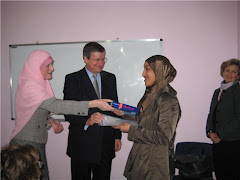"Random House Dictionary of Popular Proverbs and Sayings" by Gregory Y. Titelman says the above phrase 'you made your bed, now you lie in it', has been traced back to about 1590 and is related to the fifteenth century French proverb 'Comme on fait son lit, on le treuve' (As one makes one's bed, so one finds it). It was included in George Herbert's collection of proverbs in 1640 and in James Kelly's collection in 1721. It was first attested in the United States in 'Cy Whittaker's Place' (1908) by J.S. Lincoln, and is found in varying forms..." however, today I use it in an ironic form.
This week has had an infection control feel. It started whilst undertaking written tests of doctors English levels in a local hospital where I witnessed a patient argueing with a doctor. As my Algerian is still at elementary level, I asked a nurse in French what it was all about and she explained that the patient was insisting on using their own linen despite the hospital policy prohibiting this.
I was confused but pleased to hear that the hospital had such a policy as last year, a family member had been asked by a different hospital to bring their own linen with them as the hospital had run out.
My confusion and a well-timed lesson entitled 'patients expectations' enabled me to explore this further in my weekly Medical English class.
The doctors told me that patient's bring their own linen, and sometimes even their own mattress, as they do not trust the hospital linen to be clean. The lack of a regular water supply was partly blamed for the hospital's inability to provide a reliable quality service.
This is certainly something I'd be interested in investigating further and as luck would have it, I was fortunate enough to meet a Professor specialising in Infection Control just a few days later.
Unfortunately, we did not have time to discuss this particular matter on this occasion although I will try to remember next time we meet and add any insights to the blog later.
Instead, we discussed the system which her hospital has introduced where a 'link-person' for infection control has been identified in each department. This person is responsible for attending meetings to discuss any changes and then disseminating the information to their colleagues to ensure the message reaches as many staff as possible. This is a method of communicating important information with which I am familiar from the UK where it has been used to effectively update staff on universal issues such as diabetes, latex allergy and infection control amongst others.
I was also interested in her current work looking into the benefits of screening certain patients for MRSA prior to surgery following a high incidence on recent random screening, again a well-established practice in the UK following front page headlines of the infection's 'superbug' status.
At first, I was shocked to see that well recognised methods of infection prevention are only just being considered in Algeria but then I marvelled at the motivation of the Algerian doctors who, despite the difficulties they face, continue to strive to improve the conditions for their patients.
I was invited to the 1st Hospital Hygiene and Fight Against Nomocomial Infections Study Day being organised by her department and I am very much looking forward to attending, learning more about the Algerian health service and working with the inspiring people who work in it.
Welcome to our blog, in association with Hopeland Institute. Join other Algerian doctors, nurses and medical professionals online. Share and discuss the lastest news, share information, raise concerns, find solutions, make contacts.......the possibilities are endless. Hopeland Institute makes learning Medical English convenient, practical, efficient and fun!
About Me

- Hopeland Institute
- Algeria
- 100 Lot. Alioua Fodil, Cheraga, 16002, Algiers Tel: 021.371.169 Email: info@hopelanddz.com Website: www.hopelandDZ.com
What Our Students Say
'Have been in that class make me very proud.'
'I learn a lot of thinks with you,and I spend good times.'
'For me it was wonderful experience to get courses by someone like you .....and especially a native speaker'
'I liked almost everything about the Medical English and you as a teacher'
For more comments please see: http://algerianmedics.blogspot.com/2009/07/have-your-say.html
'I learn a lot of thinks with you,and I spend good times.'
'For me it was wonderful experience to get courses by someone like you .....and especially a native speaker'
'I liked almost everything about the Medical English and you as a teacher'
For more comments please see: http://algerianmedics.blogspot.com/2009/07/have-your-say.html
British Ambassador's Visit

Congratulations!!!!!
We're here to help!
At the head of our Medical English program is Mrs Louise Bensaid, an experienced, qualified, professional, native-speaker teacher with over 17 years of experience in the medical field in Britain including the training of doctors and nurses within her field.
Our Team
Useful sites
- Research Training
- Ibn Badis Scientific
- Direction Generale de la Recherche Scientifique et du Developpement Technologique DG-RSDT
- Centre de Recherche sur l'Information Scientifique et Technique
- Algerian Association of Skilled Workers
- Access to English Articles
- Hamma National Library
- Medical Listening Practice available at Hopeland
- Le Guide de la Sante en Algerie
- Le Guide de la Medecine et de la Sante au Maghreb
- Hopeland Institute
Followers
Consulting, Seminars and Classes
Hopeland Institue can help you keep up with the latest medical information in a number of different ways:
Speak to a consultant.......
Analysis and Advice
We can save you time and effort by helping you analyse your options for studying or working abroad, within the medical field, using our expert and library of resources.
Attend a seminar...............
Stimulating Topics for Discussion
A monthly seminar, designed to practice your listening and conversation skills. Choose from a variety of stimulating topics. Why not volunteer to give a presentation yourself? Hopeland staff can guide you through the process and support you on the day.
Take a class........................
Intermediate Medical English (Level 3)
A Cambridge University-based 96-hour intermediate Medical English course divided into 3 modules and designed for your busy schedule. Each hour stands alone, creating flexibility to take each hour in any order and when you have the time!
The course is comprised of:
1) a module looking at each of the systems of the body
2) a professional research and ethics module
3) a foundation module, which includes 'taking a history' and
diagnostic investigations
Health-Related Conversation Class
Stimulating conversation classes for level 3 students and above on diverse topics from 'The Global Trade of Body Parts' to 'Dangerous Siestas' and 'Fighting Malaria in Africa', each designed to enable you to practice your spoken English through lively discussion and debate guided by a native speaker.
Advanced Level Medical English
Coming soon!
Be a Pioneer!

Share your views, experience or research with colleagues at international conferences.
Hopeland Institute staff can make it possible. We can:
* Help you write and submit an abstract for publication
* Help you prepare talks and accompanying slides
* Offer presentation skills training
* Liaise with the conference organisers
* Support you on the day
There's nothing to lose and everything to gain so let us help you realise your potential!
Hopeland Institute staff can make it possible. We can:
* Help you write and submit an abstract for publication
* Help you prepare talks and accompanying slides
* Offer presentation skills training
* Liaise with the conference organisers
* Support you on the day
There's nothing to lose and everything to gain so let us help you realise your potential!
No comments:
Post a Comment